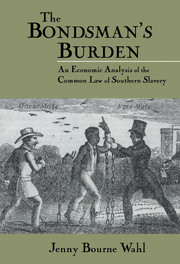Book contents
- Frontmatter
- Contents
- Acknowledgments
- 1 American Slavery and the Path of the Law
- 2 The Law of Sales: Slaves, Animals, and Commodities
- 3 The Law of Hiring and Employment: Slaves, Animals, and Free Persons
- 4 The Law Regarding Common Carriers: Slaves, Animals, Commodities, and Free Persons
- 5 The Law Regarding Governments, Government Officials, Slave Patrollers, and Overseers: Protecting Private Property versus Keeping Public Peace
- 6 The Legal Rights and Responsibilities of Strangers Toward Slaves, Animals, and Free Persons
- 7 Treatment of One's Slaves, Servants, Animals, and Relatives: Legal Boundaries and the Problem of Social Cost
- 8 The South's Law of Slavery: Reflecting the Felt Necessities of the Time
- Notes
- Index
2 - The Law of Sales: Slaves, Animals, and Commodities
Published online by Cambridge University Press: 24 October 2009
- Frontmatter
- Contents
- Acknowledgments
- 1 American Slavery and the Path of the Law
- 2 The Law of Sales: Slaves, Animals, and Commodities
- 3 The Law of Hiring and Employment: Slaves, Animals, and Free Persons
- 4 The Law Regarding Common Carriers: Slaves, Animals, Commodities, and Free Persons
- 5 The Law Regarding Governments, Government Officials, Slave Patrollers, and Overseers: Protecting Private Property versus Keeping Public Peace
- 6 The Legal Rights and Responsibilities of Strangers Toward Slaves, Animals, and Free Persons
- 7 Treatment of One's Slaves, Servants, Animals, and Relatives: Legal Boundaries and the Problem of Social Cost
- 8 The South's Law of Slavery: Reflecting the Felt Necessities of the Time
- Notes
- Index
Summary
In the village of Sharpsburg, Maryland, scarcely a mile from the site of the 1862 Union victory that served as catalyst for the Emancipation Proclamation, rests a small stone. It is unremarkable save for its inscription: “From 1800 to 1865 This Stone Was Used as a Slave Auction Block. It has been a famous landmark at this original location for over 150 years. ” As these words testify, slave sales were commonplace in the antebellum – and even Civil War – South. Like all commercial transactions, slave sales spawned litigation. Indeed, disputes surrounding the sales of slaves constitute one-sixth of all appellate slave cases. Judges drew on general legal principles, including those concerning the sale of animals, to settle such disputes. Yet the humanness of the property sold – and its value to the Southern economy – complicated the determination of liability and the types of remedies used by judges, as well as the terms of the sale contracts themselves.
In what follows, I first hypothesize as to why the law of slave sales differed from that of other commodities, particularly livestock. I then apply economic analysis to three sets of cases: those in which specific covenants such as warranties gave rise to the dispute; those in which judges determined liability based on parties' representations and knowledge rather than on express stipulations; and those in which people other than owners had sold the slaves. I find that slave sales law developed in a way that minimized the cost and uncertainty of trafficking in human flesh and, thus, strengthened the institution of slavery. I also suggest that, in some cases, divergent legal rules reflected disparate market characteristics.
- Type
- Chapter
- Information
- The Bondsman's BurdenAn Economic Analysis of the Common Law of Southern Slavery, pp. 27 - 48Publisher: Cambridge University PressPrint publication year: 1997



